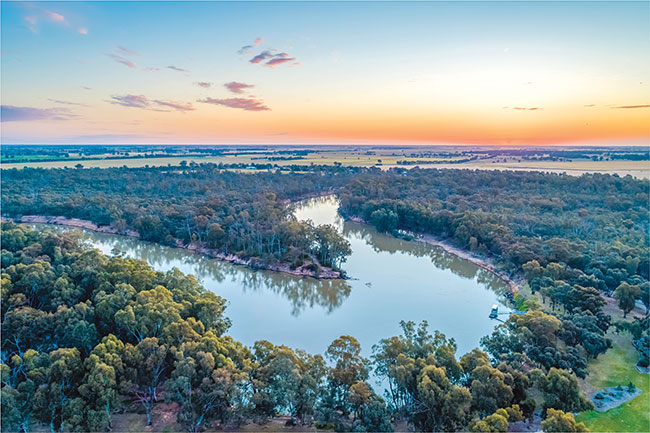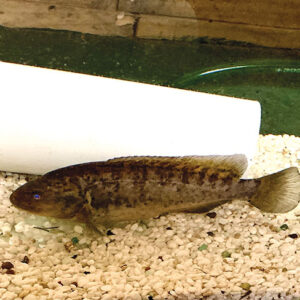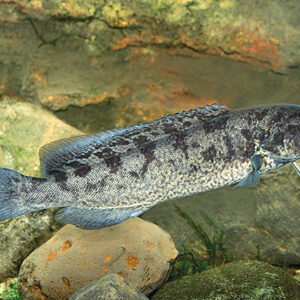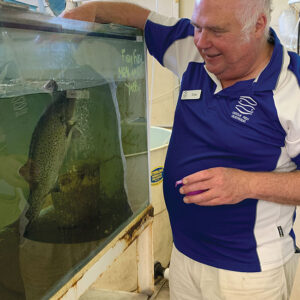
Features
Breeding
Genetics Week
Restocking
Spawning breakthrough in Australia’s Murray River
Australian citizen scientists work to revive the endangered river blackfish.
March 20, 2024 By John Mosig
 The Australian river blackfish can be found in the lower reaches of the Murray Darling Basin.
Photo: tsvibrav / iStock / Getty Images Plus / Getty Images
The Australian river blackfish can be found in the lower reaches of the Murray Darling Basin.
Photo: tsvibrav / iStock / Getty Images Plus / Getty Images The Australian river blackfish (Gadopsis marmoratus) has long been the subject of debate amongst the scientific community. There is even conjecture that it may not belong in the family Gadopsidae and should be listed as a member of the temperate water perch family, Percichthyidae.
It is endemic to southeastern Australia and found in coastal drainages as well as the lower reaches of the Murray Darling Basin (MDB). The controversy centres on the fish’s different appearance under different environmental regimes. These can range from the lowland and highland reaches of temperate coastal rivers to the sluggish flows of the MDB and the highland reaches of its southern tributaries.
It has now been divided into three allied species based on their range and differences. Those found in the upper reaches have been called the two-spined blackfish (Gadopsis bispinosus). Similar in appearance to river blackfish, their dorsal fin usually has one to three spines as compared to the seven to 13 of its floodplain cousins. Of the four varieties of coastal freshwater blackfish, those found in Victoria have been named Gadopsis gracilis.
Varieties are also found in the upland streams of the isolated Grampians in Western Victoria and the Mount Lofty Ranges in South Australia. This would suggest a heritage of some antiquity.
About the species
While the scientific community battles with the taxonomy, the angling community has no problem defining what has become the sluggish inland water “slimy”, the upper reaches inland “northern blackfish”, and the coastal catchment “southern blackfish”. The inland species have a maximum size of 30 cm and the coastal variety has been recorded at 60 cm and 5.5 kg.
Once abundant, farming practices, river and land clearing, and the consequential silting, have placed pressure on the species’ habitat options. It has disappeared from many of its catchments and is vulnerable elsewhere.
Nevertheless, blackfish have proven to be a resilient species where it can find a suitable niche. In the wild, they have been impacted by introduced trout, however, they’ve thrived in farm water impoundments.
The fish is not fecund; the average spawning is 800-1,000 eggs. The female deposits the adhesive eggs in a hollow log or a protected gravel bed. Once fertilized, the male guards and aerates the eggs for an incubation period of 14-16 days. The larvae remain tethered to the eggshells by a fine thread while they absorb their yolk sacks over a further 14 days and remain guarded until they become free-swimming fry (20-25 mm) after another seven days.
To the rescue
Apart from establishing the genetic integrity of the species from its various catchments, government agencies had shown little appetite for developing restocking programs, and breeding protocols were left to enthusiasts to explore. Enter Stephen and Sherryl Mueller.
They’re long-term members of Native Fish Australia (NFA), a volunteer body dedicated to the preservation of Australia’s rich heritage of indigenous species, particularly the endangered trout cod (Maccullochella macquariensis) and Macquarie perch (Macquaria australasica).
The Mueller’s progress, like that of so many pioneers in this field, was a trial-and-error process.
Unable to visually sex the fish, they stocked what they hoped were breeding combinations in tanks in the hatchery hothouse. When this proved unsuccessful they reverted to nature. They had observed the overlapping habitat and biological similarities between Murray cod (Maccullochella peelii peelii) and the far shyer and smaller blackfish, so they introduced spawning drums to the broodstock holding ponds.
The drums produced results and the egg screens from the drums were removed to the hatchery. The results were unsatisfactory, so they built dedicated spawning ponds.
Stocking each pond with a breeding team of five to seven fish and monitored the ponds constantly once the temperatures had reached 16 C. They knew blackfish were nocturnal so they placed shrimp traps in the ponds to remove the free-swimming fry and rear them on rotifers and copepods in the hatchery tanks.
Stephen laboriously monitored them – in case predatory invertebrates and crustaceans invaded the traps – on an hourly basis throughout the night. It was then that he discovered that the juvenile fish, once they’d left the nesting area, were diurnal. Stephen put this down the predatory nature of the adult fish in the ponds. Trapping, as intensive as it was, worked and they set about streamline the system.
“They’re extremely shy fish, and stress easily. We can reduce stress by anesthetizing them first, but they still don’t take kindly to handling,” Stephen said. “Saprolegnia tends to be a problem. Because we’re using a natural environment to induce spawning, we keep handling to a minimum. It would advance the program to get some tags on them once the gender of particular fish has been established.”
The next step was to install 4,500-litre circular, concrete cattle troughs. By dividing them with mesh they were able to “draft” the fry to one side of the tanks and remove the adult breeding team once they’d completed the spawning and hatching process.
Feeding knowledge
Working under such restrained conditions, nutrition was another element of the cycle they had to consider. Species specific diets were out of the question; the commercial fry and broodstock diets available were designed for cold-water salmonids or tropical barramundi.
As keen observers of nature, they established what would be accessible to the blackfish locally and seasonally and went about, where possible, developing a controlled source of the identified food items.
They also fertilized the ponds to enhance zooplankton production for the juveniles, which further added to the labour intensity of the process.
The first identified, and easily produced, was the ubiquitous freshwater crayfish, known across Australia as the yabby (Cherax destructor). While dedicated ponds supplied this base to the fishes’ diet, the supply slowed during the colder months. Cultivated mealworms (Tenebrio molitor L.) provide another constant nutrient for broodstock and juveniles.
Seasonal cycles and the odd purchased prawns and blood worms provided the balance of the diet. The Otway region is rich in scrub worms and by enhancing their habitat on the farm, they proved a rich source of nutrition through the winter months. Come the summer and black crickets are prolific, followed in the autumn by the emergence of bardee moths (Abantiades atripalpis).
A bonus to this labour-intensive diet was that the boosted nutritional intake led to serial spawnings and the breeding program was able to be continued across the warmer months.
Community outreach
They fund the operation with sales to aquarium enthusiasts and out of their own pockets.
“Genetically, the stock we raise are akin to our local Otway catchment but forestry clear felling and farming practices, especially the over-use of chemicals, have compromised their habitat so badly it’s probably a waste of time restocking them in the wild,” Stephen said.
“I need to expand my set-up and have been talking with NFA president, Tim Curmi. It’s been a real breakthrough for this endangered species and with just a little funding we’d make some serious steps toward being able to stock enough suitable waterways and impoundments to give this beautiful fish some much-needed breathing space.”
Hatchery International caught up with NFA president, Tim Curmi, at the association’s new La Trobe University hatchery. He was particularly excited about the breakthrough that Stephen and Sherryl Mueller had achieved.
“They’ve worked tirelessly at their own expense and with limited facilities to reach this point. We have two members who did their post-graduate theses on the ecology of river blackfish and NFA will be supporting their endeavours at our new facility,” said Curmi.
“There’s been a lamentable lack of interest in blackfish from the authorities. Five years ago we requested, to reduce angling pressure, that the Victorian Fisheries Authority (VFA) reduce the bag limit to two fish and increase the minimum size to 30 cm.”
The above demonstrates how the efforts of dedicated citizen scientists, using observation and ingenuity, can make a huge difference in not only saving an endangered species but ensuring its survival into a future threatened by environmental pressures.
“This development in their breeding program will provide us with a launching pad to promote the plight of this wonderful ancient species to environmental bodies and its value as a sport and eating fish to the angling community,” said Curmi.
This article is part of the Genetics Week
Print this page
Advertisement
- Updates to BAP salmon farm standard available for public review
- OAA 2024: Ontario ministry vet identifies fish health threats to be wary









